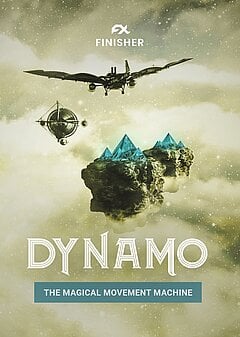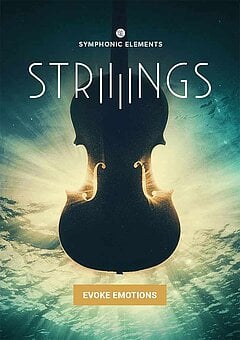How to Make Dark and Ambient Records - Halloween Edition
Production techniques for soothing, ethereal and spooky ambient music with ease using STRIIIINGS, DRUMS and Finishers
OCTOBER 31ST, 2021
Read this article to explore some techniques that will add a dark and spooky atmosphere into your ambient records:
Deciding on a mood
Much of an ambient producer’s job is “impressionist” in nature — that is, creating a soundscape designed to evoke a static feeling, almost as though it’s been frozen in time. This can be a difficult shift in mentality, because there are no drops, choruses or even verses (at least, not in the conventional sense). Instead, your job is to build an atmosphere and keep it enjoyable for the entire song length. Ambient music tends to be quite long!
Your default ‘ambient sound’ will likely be gentle and soothing ... but what if you want to make things a bit spookier? With a few very simple changes, you can completely change the vibe of the entire song (this goes beyond just switching from a major to a minor key!). For example, add distortion after some of your reverbs and they’ll instantly sound eerier and grittier. Add more inharmonic sounds and create dissonant harmonies on top of your chords, such as adding a Bb and F to an A minor chord, which is normally only A, C and E. Add a creepy bass drone below the rest of your mix.
Try adding in a variety of human sounds as well, such as laughter, screams, or anything else that comes to mind. To make them less obvious, filter them (both high and low pass), add heavy distortion and drown the sample in reverb. The result is an atmospheric effect that vaguely resembles a voice, but is difficult to place. Listeners will catch the effect subliminally and may become unsettled — which, if you’re going for the spooky approach, might be exactly what you want! A little uncertainty goes a long way.
Whatever techniques you try out, the possibilities are endless. Simply start with a feeling in mind and start producing, shaping things as you go. Most of the tips you’ll read here work for any ambient songs, regardless of the mood you choose!
Building out chords
The foundation of your ambient songs will likely be synth chords, but if you’re not 100% certain what sound you want to start with, piano and strings are always safe options since they blend with almost anything soft. You can even begin with nothing more than whole note chords in the piano and copy them over to a virtual string instrument pre-loaded with rhythmic phrases for every chord you play, such as Symphonic Elements STRIIIINGS. This way, you get a very full sound out of minimal effort — just be sure to choose a rhythmic phrase that fits the feel of the song and dial back the volume until it’s nice and subtle.
Ambient music chord progressions are different from other genres in that they’re typically less focused. Instead of constantly leading you to the next phrase or section, you have the freedom to explore every chord more fully. Let it grow, fade, morph or anything you else choose. Be less intentional about your decisions, focusing simply on what sounds good, rather than what gives you a nice setup for a build. Your chords can be soothing and open, such as sus2 and sus 4 chords. But in case you came here for the promise of Halloween spookiness...
One of the simplest ways to make your chord progressions darker is to make every chord minor in some of the major sections of the song. While this may sound silly, having no major chords creates the impression that there’s no hope — just be sure to do this tastefully and not overuse this technique, otherwise it can sound cheesy and cartoonish!
Where’s the rhythm?
Depending on your taste, you may opt for minimal percussion or none at all. You may find it difficult to articulate what the rhythm of the song is (if there is one) — if that’s the case, you’re better off adding a bit of percussion to shape the song a bit more. However, you don’t want to have overbearing electronic percussion, nor do you want a raw drum kit sound when you’re creating a calm and gentle space! Cinematic percussion like UJAM’s Symphonic Elements DRUMS is a great choice, since its “size” implies a big space, sliding neatly into any reverb and spatial effects you use in the mix. Just be sure to dial it back a bit so the drums don’t cut through everything else — they should only provide a gentle pulse to keep all the elements of your song together.
Percussion is far from the only way to create rhythm, however. You can add timed synth plucks, create vibrato, retrigger chords, use arpeggios, and many other subtle options to add variety without overusing any one of them. This is a balancing act, as ambient music is quite static when compared with other genres, but if the sound is too consistent or one-dimensional, the entire song will begin to sound like noise. The good news is that you can get away with less frequent chord changes and slower rhythms; when you find something that works, you can take your time expanding upon it and unfolding it into something new. Over time you’ll develop a sense of how much repetition is too much, and it will become far quicker and more natural to create the perfect rhythm in your ambient songs.
Sound design
This is one of the most rewarding aspects of ambient music, because the timbre of each sound has the power to change the intensity of your entire mix. There are some excellent multi-effects that allow you to create complex soundscapes in very little time, such as Finisher FLUXX, which you should absolutely take advantage of when creating more complex sounds.
However, it’s valuable to understand the building blocks of this style of sound design, which largely comes down to a few very common audio effects.
One of your biggest friends in this style is filtering — especially low pass (for a dreamy, soft sound) but high pass as well (to keep your bass range clean). When you think of ambient music, you likely don’t imagine bright, harsh textures, and there’s a reason for that! Slowly raising or lowering the cutoff frequency is a simple but effective way to create variety and gradually change the character of the song, particularly if you’re doing it with multiple synths at different frequencies all at once.
Add in reverb, and you’re already most of the way there. Because space is a huge aspect of ambient music, the type of reverb you use is important. You could choose to use a convolution reverb of a recorded space with Audio Ease’s Altiverb or EastWest’s Spaces II, or a dreamy algorithmic reverb like Valhalla Shimmer — preferably a combination of both as desired, because they offer distinctly different possibilities. Bringing them together allows you to create a combination of real and “imaginary” spaces, which is a key element of many ambient producers’ works.
Used sparingly, another excellent tool type to add to your arsenal is volume-based effects such as tremolo and glitches. If you want to dip into that realm, Finisher DYNAMO offers everything you need in a clean, simple interface to help you create sounds you didn’t know were possible in mere moments. Volume modulation allows you to create new rhythms, which is an excellent way to create movement without the need for constant percussion — simply adding a volume-based effect at the end of your effect chain will completely change the role of the sound you created, without further complicating your processing.
Wrapping up
Ambient music is deceiving — it may appear simpler to create than other genres, but in place of the complications of other genres, all the subtle nuances matter more. Listeners can instantly tell when something’s off, so every sound must be placed carefully in the arrangement. The tradeoff is that every sound can take you even further with only subtle tweaks to filters, reverb, volume effects, and any other ways you choose to shape your sounds. You’ll find the most creative success by focusing on creating spaces and atmospheres that gradually change over time, not by following a specific song structure; plus, since you can be far more lenient with rhythm, you can opt for light cinematic percussion or even none at all.
The default character of ambient music is gentle and ethereal, but it also allows for dark and unsettling sounds if you choose. In fact, this is a fantastic way to create Halloween-themed music! Play with dissonance, gritty effects, and of course, minor keys — throwing in foley, human and designed sounds as you like. The eerier the better. This is a fantastic gateway into writing music for horror and discovering new ways to scare and thrill your audience! You also don’t have to edit your ideas heavily since you’re less confined than in a song that has a clear melody, verse / chorus structure, etc. Taking a “stream of consciousness” approach can even lead to more creative ideas. You can also create gradual build-ups and master the art of producing suspenseful music. Ambient music is a path to tons of dark and twisted fun ... though you can always opt for something more subdued, of course.
Perhaps the best part is that if something sounds good in a specific moment, it doesn’t take much to fit it into the song; fade the surrounding textures in and out, and a good musical idea will never feel too sudden. Once you get into the flow, ambient music is a ton of fun; start with a single idea and grow it, whether it’s with piano, synths, or any other source of inspiration. Most importantly, allow it to evolve over time rather than “writing” in the conventional sense — then you’ll never be at a loss for ideas.
Stay up to date
Sign up and we’ll send you an e-mail with product news and helpful stuff every now and then. You may unsubscribe at any time.
Defy Limits
We develop software solutions that enable people to create, consume and interact with music.




